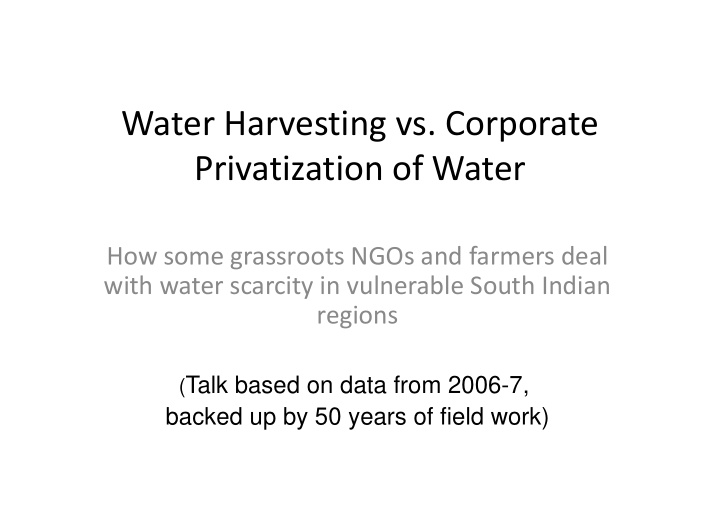



Water Harvesting vs. Corporate Privatization of Water How some grassroots NGOs and farmers deal How some grassroots NGOs and farmers deal with water scarcity in vulnerable South Indian regions ( Talk based on data from 2006-7, backed up by 50 years of field work)
My concern today is: How can we deal with water scarcity? • Focus on areas away from coasts for this presentation and examine both the present situation and future options • Situation is very serious because the area in • Situation is very serious because the area in question, primarily the central and southern reaches of the Deccan plateau has vast arid and semi-arid areas along with increasing population.
Reasons for lack of focus on global warming in India: 1. The (realistic) belief that the developed countries, esp. the US are the prime agents of global warming---though even as I talk, elites in both India and China are struggling to become like the “west” which will also help to cause vast damage to the planet. 2. In areas of South India covered here, there have always been tremendous fluctuations in rainfall---at least during the past two centuries, and possibly during the whole past millennium. One example: Chinglepet Dt. 1907-8 or 1959-60 vs 1951-52 area irrigated paddy (over 500,000 acres vs. 340,000 acs. Resulting from great fluctuations in both the SW and NE monsoons.
Introduction to maps The following slides, which I will rapidly pass over, show topographic and water characteristics of the areas being discussed. Our data covers a large area, and the NGOs I and our investigators worked with differ in: 1.expected rainfall during worked with differ in: 1.expected rainfall during each of the monsoons, 2. soil type and soil porosity, 3. population density, newness of settlement (e.g. Wayanad), and 4. a wide variety of other ecological, socio-economic, and cultural dimensions.
N A T U R A L R E G I O N S
R A I N F A L L
I R R I G A T I O N
Policies in the past that have made water conservation and protection harder • Allowing and at times even encouraging the unplanned and indiscriminate drilling of bore wells that drain the aquifers • Indiscriminate mining of the sand at the bottom of rivers, causing them to run too rapidly out to of rivers, causing them to run too rapidly out to sea and drastically reducing the water level for large parts of the year (see next slide) • Focusing on large-scale public works such as big dams, instead of small scale check dams that local people can maintain
SAND MINING
Check dam during dry season
Another check dam in the rainy season
CARTOON FROM CSA, HYDERABAD, USED FOR EDUCATION OF LOCAL PEOPLE
Another CSA educational slide
Former Problematic Policies (continued) • Failure to pay attention to effects of increasingly large amounts of chemical fertilizers and pesticides and residual run-off • Gradual shift to mono-cropping and growing focus on exports to the detriment of family foods • Major destruction of forests which traditionally • Major destruction of forests which traditionally captured monsoon water, preventing landslides, etc. • Failure to give local water users’ associations enough local autonomy so that many have fallen into disuse
Policies continued • Failure to plan for expected large urban and semi- urban migration and need for water--the traditional urban vs. farmer disputes • Diverting water from watersheds for local food consumption, and using drinking water to produce export crops (though no one has studied what happens to the income from these crops) happens to the income from these crops) • Failure to require upstream factories to care for their waste and effluent so that downstream people can drink and use clean water. • Deflection of water to urban users with no regard for rural needs
Alternatives • Because of lack of funds to repair water sources, pipes, etc. and care for water filtration, some municipalities in India are thinking about inviting in foreign corporations such as SUEZ, despite considerable local protest. Whether this will actually happen remains to be seen, but clearly there are many ways that water usage can be controlled. ways that water usage can be controlled. • The NGOs we worked with are helping with rural water conservation through: – Encouraging the repair of tanks, eris and wells and using the silt removed as extremely rich fertilizer – Creating small ponds in approximately 1/10 of the size of a farmers field to allow for a small pond and building channels that slope towards the ponds
Small pond at edge of paddy field, with duck house on top. Duck manure drops in the pond.
Fish are being harvested from the same pond.
Recommend
More recommend